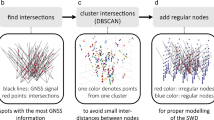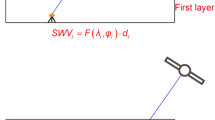Abstract
Tropospheric tomography is one of the most important techniques to reconstruct three-dimensional (3D) images of the tropospheric water vapor fields using a local GNSS network. In the conventional tropospheric tomography method, called voxel-based tropospheric tomography, the 3D space is divided into many voxels and the amount of water vapor is estimated for each voxel. This method suffers from three disadvantages. First, it needs empirical constraints in order to fix the rank deficiency of the coefficient matrix. Second, the amount of water vapor is assumed to be constant in the 3D space of a voxel despite the large spatial variations of this parameter. Third, the number of unknown parameters is high compared to the number of observations. Therefore, an approach based on mathematical functions, called function-based tropospheric tomography, is presented to overcome these problems. The tropospheric tomography using the voxel-based and function-based approaches is performed using 17 GPS stations. Radiosonde observations and precise point positioning results are used to validate the obtained results. A comparison of the results with the radiosonde data indicates that using the function-based method reduces the mean RMSE by about 0.3 gr/m3. Validation using positioning under different wet conditions shows that in wet weather conditions the difference between the RMSE of the two tropospheric tomography approaches is significant. All the validations show the ability and applicability of the function-based tropospheric tomography approach.
















Similar content being viewed by others
Data availability
The data sets generated during and/or analyzed during the current study are not publicly available but are available from the corresponding author on reasonable request.
References
Adavi Z, Mashhadi Hossainali M (2014) 4D-tomographic reconstruction of the tropospheric wet refractivity using the concept of virtual reference station, case study: North West of Iran. Meteorol Atmos Phys 126(3–4):193–205
Amerian Y, Hossainali MM, Voosoghi B (2013a) Regional improvement of IRI extracted ionospheric electron density by compactly supported base functions using GPS observations. J Atmos Sol Terr Phys 92:23–30. https://doi.org/10.1016/j.jastp.2012.09.011
Amerian Y, Voosoghi B, Mashhadi Hossainali M (2013b) Regional Ionosphere Modeling in Support of IRI and Wavelet Using GPS Observations. Acta Geophys 61(5):1246–1261. https://doi.org/10.2478/s11600-013-0121-5
Bender M, Dick G, Ge M, Deng Z, Wickert J, Kahle H-G, Raabe A, Tetzlaff G (2011) Development of a GNSS water vapour tomography system using algebraic reconstruction techniques. Adv Space Res 47(10):1704–1720
Bevis M, Businger S, Herring TA, Rocken C, Anthes RA, Ware RH (1992) GPS meteorology: Remote sensing of atmospheric water vapor using the Global Positioning System. J Geophys Res Atmos 97(D14):15787–15801
Böhm J, Niell A, Tregoning P, Schuh H (2006) Global Mapping Function (GMF): A new empirical mapping function based on numerical weather model data. Geophys Res Lett 33:1–4
Braun JJ (2004) Remote sensing of atmospheric water vapor with the global positioning system. Dissertation, University of Colorado.
Chen BY, Liu ZZ (2014) Voxel-optimized regional water vapor tomography and comparison with radiosonde and numerical weather model. J Geod 88(7):391–703. https://doi.org/10.1007/s00190-014-0715-y
Dach R, Lutz S, Walser P, Fridez P (Eds) (2015) Bernese GNSS Software Version 5.2. User manual, Astronomical Institute, University of Bern, Bern Open Publishing. https://doi.org/10.7892/boris.72297; ISBN: 978-3-906813-05-9.
De Boor C (1970) On calculating with B-splines. J Approx Theory 6:1970. https://doi.org/10.1016/0021-9045(72)90080-9
Elósegui P, Rius A, Davis JL, Ruffini G, Keihm S, Bürki B, Kruse LP (1998) An experiment for estimation of the spatial and temporal variations of water vapor using GPS data. Phys Chem Earth Parts A/B/C 23(1):125–130
Davis JL, Elgered G, Niell AE, Kuehn CE (1993) Ground-based measurement of gradients in the wet radio refractivity of air. Radio Sci 28:1003–1038
Dee DP et al (2011) The ERA-Interim reanalysis: configuration and performance of the data assimilation system. Q J R Meteorol Soc 137(656):553–597. https://doi.org/10.1002/qj.828
Flores A, Ruffini G, Rius A (2000) 4D tropospheric tomography using GPS slant wet delays. Ann Geophys Ger 18(2):223–234
Guo J, Yang F, Shi J, Xu C (2016) An optimal weighting method of Global Positioning System (GPS) troposphere tomography. IEEE J Sel Top Appl Earth Obs Remote Sens 9(12):5880–5887. https://doi.org/10.1109/JSTARS.2016.2546316
Haji-Aghajany S, Voosoghi B, Yazdian A (2017) Estimation of north Tabriz fault parameters using neural networks and 3D tropospherically corrected surface displacement field. Geomat Nat Hazards Risk 8(2):918–932. https://doi.org/10.1080/19475705.2017.1289248
Haji-Aghajany S, Amerian Y (2017) Three dimensional ray tracing technique for tropospheric water vapor tomography using GPS measurements. J Atmos Solar Terr Phys 164:81–88. https://doi.org/10.1016/j.jastp.2017.08.003
Haji-Aghajany S, Amerian Y (2018) Hybrid Regularized GPS Tropospheric Sensing Using 3-D Ray Tracing Technique. IEEE Geosci Remote Sens Lett 15(10):1475–1479. https://doi.org/10.1109/LGRS.2018.2853183
Haji-Aghajany S, Voosoghi B, Amerian Y (2019) Estimating the slip rate on the north Tabriz fault (Iran) from InSAR measurements with tropospheric correction using 3D ray tracing technique. Adv Space Res 64(11):2199–2208. https://doi.org/10.1016/j.asr.2019.08.021
Haji-Aghajany S, Amerian Y, Verhagen S, Rohm W, Ma H (2020) An optimal troposphere tomography technique using the WRF model outputs and topography of the area. Remote Sens 12(9):1442. https://doi.org/10.3390/rs12091442
Haji-Aghajany S, Amerian Y (2020) Atmospheric phase screen estimation for land subsidence evaluation by InSAR time series analysis in Kurdistan. Iran J Atmos Sol Terr Phys 164:81–88. https://doi.org/10.1016/j.jastp.2020.105314
Hansen PC (1997) Rank-deficient and Discrete Ill-posed Problems. Numerical aspects of linear inversion, monographs on mathematical modeling and computation, vol 4. SIAM, Philadelphia
Hirahara K (2000) Local GPS tropospheric tomography, Earth Planet. Space 52:935–939
Magee L (1998) nonlocal behavior in polynomial regressions. Am Stat 52(1):20–22. https://doi.org/10.2307/2685560.JSTOR2685560
Mautz R, Ping J, Heki K, Schaffrin B, Shum CK, Potts L (2005) Efficient spatial and temporal representations of global ionosphere maps over Japan using B-spline wavelets. J Geodesy 78(11):660–667
Perler D, Geiger A, Hurter F (2011) 4D GPS water vapor tomography: new parameterized approaches. J Geodesy 85(8):539–550
Rohm W, Bosy J (2009) Local tomography troposphere model over mountains area. Atmos Res 93(4):777–783
Rohm W, Zhang K, Bosy J (2014) Limited constraint, robust Kalman filtering for GNSS troposphere tomography. Atmos Meas Tech 7(5):1475–1486
Saastamoinen J (1973) Contributions to the theory of atmospheric refraction. Part II: refraction corrections in satellite geodesy. Bull Geod 107:13–34
Troller M, Burki B, Cocard M, Geiger A, Kahle HG (2002) 3-D refractivity field from GPS double difference tomography. Geophys. Res. Lett. 29:2-1–2-4
Yao Y, Zhao Q (2016) Maximally using GPS observation for water vapor tomography. IEEE Trans Geosci Remote 54(12):7185–7196
Yao Y, Zhao Q (2017) A novel, optimized approach of voxel division for water vapor tomography. Meteorol Atmos Phys 129(1):57–70. https://doi.org/10.1007/s00703-016-0450-4
Yu W, Chen B, Dai W, Luo X (2018) Real-time precise point positioning using tomographic wet refractivity fields. Remote Sens 10(6):928
Zhao Q, Yao Y (2017) An improved troposphere tomographic approach considering the signals coming from the side face of the tomographic area. Ann Geophys 35(1):87–95
Zhao Q, Yao Y, Yao W (2018) troposphere water vapour tomography: a horizontal parameterised approach. Remote Sens 10(8):1241
Zhao Q, Zhang K, Yao Y, Li X, Yao W (2019) A new troposphere tomography algorithm with a truncation factor model (TFM) for GNSS networks. GPS Solutions 23(3):64. https://doi.org/10.1007/s10291-019-0855-x
Zhao Q, Liu Y, Ma X, Yao W, Li X (2020a) An improved rainfall forecasting model based on GNSS observations. IEEE Trans Geoence Remote Sens 99:1–10. https://doi.org/10.1109/TGRS.2020.2968124
Zhao Q, Yao W, Yao Y, Li X (2020b) An improved GNSS tropospheric tomography method with the GPT2w model. GPS Solut 24(2):60. https://doi.org/10.1007/s10291-020-0974-4
Acknowledgments
The authors would like to appreciate the UNAVCO for the GPS observations and for providing high‐accuracy station position time series. We are also grateful to the ECMWF for publishing ERA-Interim data.
Author information
Authors and Affiliations
Corresponding author
Additional information
Publisher's Note
Springer Nature remains neutral with regard to jurisdictional claims in published maps and institutional affiliations.
Rights and permissions
About this article
Cite this article
Haji-Aghajany, S., Amerian, Y. & Verhagen, S. B-spline function-based approach for GPS tropospheric tomography. GPS Solut 24, 88 (2020). https://doi.org/10.1007/s10291-020-01005-x
Received:
Accepted:
Published:
DOI: https://doi.org/10.1007/s10291-020-01005-x




